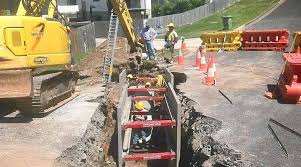Storm Water Drainage Work

About Storm Water Drainage Work
The storm drainage system helps prevent floods by diverting rainwater into nearby waterways. During rainstorms, water runs off of buildings, roads, and other hard surfaces, picking up trash and pollutants along the way. The water and pollutants flow into storm drains and through underground pipes directly into the nearest stream, pond or water reservoir.A storm drain, storm sewer, surface water drain/sewer, or stormwater drain is infrastructure designed to drain excess rain and ground water from impervious surfaces such as paved streets, car parks, parking lots, footpaths, sidewalks, and roofs. Storm drains vary in design from small residential dry wells to large municipal systems.
Drains receive water from street gutters on most motorways, freeways and other busy roads, as well as towns in areas with heavy rainfall that leads to flooding, and coastal towns with regular storms. Even gutters from houses and buildings can connect to the storm drain. Many storm drainage systems are gravity sewers that drain untreated storm water into rivers or streams so it is unacceptable to pour hazardous substances into the drains.Storm drains often cannot manage the quantity of rain that falls in heavy rains or storms[citation needed]. Inundated drains can cause basement and street flooding. In many areas require detention tanks inside a property that temporarily hold runoff in heavy rains and restrict outlet flow to the public sewer. This reduces the risk of overwhelming the public sewer. Some storm drains mix stormwater (rainwater) with sewage, either intentionally in the case of combined sewers, or unintentionally.
A stormwater drainage system should be designed to collect and convey run-off generated within a catchment area during and after rainfall events, for safe discharge into a receiving watercourse or the sea. the assessment of the performance of the existing stormwater drainage system within a catchment and the design of a new or upgraded system to allow for the impact of new development within the catchment and/or to assess the necessity and feasibility of bringing the flood protection standards up to the levels recommended.An open channel or drain system generally consists of a secondary drainage system, with a network of small drains attached (micro-drainage).Poorly managed stormwater can cause problems on and off site through erosion and the transportation of nutrients, chemical pollutants, litter and sediments to waterways. Well-managed stormwater can replace imported water for uses where high quality water is not required, such as garden watering.
The most basic way to drain off rain and stormwater is via open channels. A more developed but also more expensive solution is a separate sewer system. Separately collected stormwater has high potential for increasing agricultural production in rural areas. In addition a more integrated approach to water management in urban areas can be achieved by replenishing freshwater resources after a natural pre-treatment of the collected stormwater (e.g. free-surface constructed wetlands) and a recharge of surface or groundwater bodies (see also stormwater management). In both cases the receiving water bodies may be sea, lake, river or groundwater (also see surface disposal of liquids, surface groundwater recharge, subsurface groundwater recharge).

